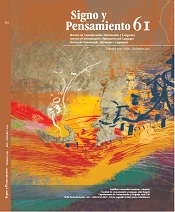Abstract
This paper analyzes transmedia practices within the context of female fiction in two television series: TV3- Televisió de Catalunya’s ‘Infidels’ and BBC’s ‘Mistresses’. The research combines semiotic and narratological approaches, useful for identifying and describing interpretative and narrative strategies that fit female fiction features or other works with a great range of characters and plot arcs. In addition, such strategies are helpful to reflect on fan-made productions, an increasing part of the transmedia ecosystem.
Ardévol, E., Roig A., Gómez-Cruz, E. & San Cornelio, G. (2010). Prácticas creativas y participación en los nuevos media. Quaderns del CAC, 13(1), 27-28. Recuperado de http:// bit.ly/KbGVCP
Askwith, I. (2007). Television 2.0: Reconceptualizing TV as an engagement medium. Tesis de Máster en Comparative Media Studies, MIT. Recuperado de http://cms.mit.edu/research/ theses/IvanAskwith2007.pdf
Bacon-Smith, C. (1992). Enterprising women: Television fandom and the creation of popular myth. Philadelphia, PA: University of Pennsylvania Press.
Bal, M. (1987). Teoría de la narrativa (Una Introducción a la Narratología). Madrid: Cátedra.
Baym, N. K. (2000). Tune in, log on: soaps, fandom and online community. Thousand Oaks, CA: Sage Publications.
Bechmann Petersen, A. (2006). Internet and cross media productions: case studies in two major danish media organizations. Australian Journal of Emerging Technologies and Society, 4(2), 94-107. Recuperado de http:// www.swinburne.edu.au /hosting/ijets / journal/V4N2 /pdf/V4N2-3-BechmannPetersen.pdf
Belsunces Gonçalves, A. (2011). Producción, consumo y prácticas culturales en torno a los nuevos media en la cultura de la convergencia: el caso de Fringe como narración transmedia y lúdica. Trabajo Final del Máster en Sociedad de la Información y el Conocimiento, Universitat Oberta de Catalunya (UOC).
Booth, P. (2010). Digital fandom. New York, NY: Peter Lang Publishing.
Caldevilla Domínguez, D. (2010). Mujeres 2.0. Una visión sobre el consumo de Internet de la mujer de hoy. Icono 14, 8(1), 326-336.
Cascajosa Virino, C. (2006). El espejo deformado: Una propuesta de análisis del reciclaje en la ficción audiovisual norteamericana. Revista Latina de la Comunicación Social, 61. Recuperado de http://www.ull.es/publicaciones/ latina/200605cascajosa.pdf
Chatman, S. (1990). Historia y discurso. La estructura narrativa en la novela y el cine. Madrid: Taurus.
Dena, C. (2009).Transmedia practice: theorising the practice of expressing a fictional world across distinct media and environments. Tesis doctoral, University of Sydney. Recuperado de http:// dl.dropbox.com/u/30158/DENA_TransmediaPractice.pdf
Dolezel, L. (1999). Heterocósmica: ficción y mundos posibles. Madrid: Arco Libros.
Eco, U. (1981). Lector in fabula. La cooperación interpretativa en el texto narrativo. Barcelona: Editorial Lumen.
Fiske, J. (1991). The cultural economy of fandom. En L. Lewis (Ed.), The adoring audience (pp. 30-49). New York, NY: Routledge.
Genette, G. (1989). Palimpsestos. La literatura en segundo grado. Madrid: Taurus.
Grandío, M. & Hernández Pérez, M. (2011). Narrativa crossmedia en el discurso de Ciencia Ficción. Estudio de Battlestar Galactica (2003-2010). Área Abierta, 28, 1-20.
Greimas, A. y Courtés J. (1982). Semiótica. Diccionario razonado de la teoría del lenguaje. Vol. 1. Madrid: Gredos.
Guerrero, M. (en prensa). Webs televisivas y sus usuarios: un lugar para la narrativa transmedia. Comunicación y Sociedad.
Gwenllian Jones, S. (2002). Phantom Menace: killer fans, consumer activisim and digital filmmakers. En X. Menkik y S.J. Schneider (Eds.), Underground USA. Filmmaking beyong the Hollywood canon (pp. 169-179). London: Wallflower Press.
Hellekson, K. & Busse, K. (Ed.). (2006). Fan fiction and fan communities in the age of the internet. Jefferson, NC: McFarland.
Hills, M. (2002). Fan cultures. Londres: Routledge.
Jenkins, H. (1992). Textual poachers: television fans and participatory culture. London: Routledge.
Jenkins, H. (2008). Convergence culture. La cultura de la convergencia de los medios de comunicación. Barcelona: Paidós.
Jenkins, H. (enero, 2003). Transmedia storytelling. Moving characters from books to films to video games can make them stronger and more compelling. Technology Review. Recuperado de http:// www.technologyreview.com/biomedicine/13052/
McCombs, M. E., & Shaw, D. L. (1972). The agenda-setting function of mass media. Public Opinion Quarterly, 36(2), 176-187.
Penley, C. (1992). Feminism, psychoanalisis, and the study of popular culture. En L. Grossberg, C. Nelson & P.A. Treichler (Eds.), Cultural studies (pp. 479-500). New York, NY: Routledge.
Perryman, N. (2008). Doctor Who and the convergence of media. A case study in transmedia storytelling. Convergence: The International Journal of Research into New Media Technologies, 14(1), 21-39.
Ryan, M. L. (2004). Narrative across media. Lincoln, NE: University of Nebraska Press. Scolari, C. A. (2009). Transmedia storytelling: implicit consumers, narrative worlds, and branding in contemporary media production. International Journal of Communication, 3, 586-606.
Scolari, C. A. (en prensa). Lostology: Transmedia storytelling, cross-media strategies and narrative around the island. Semiótica.
Scolari, C. A., Jiménez, M. & Guerrero, M. (2012). Narrativas transmediáticas en España: cuatro ficciones en busca de un destino cross-media. Comunicación y Sociedad, 25 (1), 137-164.
The Cocktail Analysis. (2011). Informe ‘Televidente 2.0’. Quinta edición, septiembre de 2011. Recuperado de http://www. slideshare.net/TCAnalysis/televidente2011-pblico-9345446
Valencise Gregolin, M. (2010). Viver a vida no limiar da tela: a narrativa transmídia chega à novela. Revista Geminis, 1(1), 53-67.
This journal is registered under a Creative Commons Attribution 4.0 International Public License. Thus, this work may be reproduced, distributed, and publicly shared in digital format, as long as the names of the authors and Pontificia Universidad Javeriana are acknowledged. Others are allowed to quote, adapt, transform, auto-archive, republish, and create based on this material, for any purpose (even commercial ones), provided the authorship is duly acknowledged, a link to the original work is provided, and it is specified if changes have been made. Pontificia Universidad Javeriana does not hold the rights of published works and the authors are solely responsible for the contents of their works; they keep the moral, intellectual, privacy, and publicity rights.
Approving the intervention of the work (review, copy-editing, translation, layout) and the following outreach, are granted through an use license and not through an assignment of rights. This means the journal and Pontificia Universidad Javeriana cannot be held responsible for any ethical malpractice by the authors. As a consequence of the protection granted by the use license, the journal is not required to publish recantations or modify information already published, unless the errata stems from the editorial management process. Publishing contents in this journal does not generate royalties for contributors.


